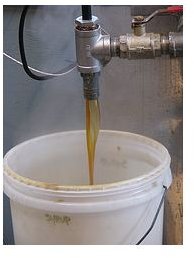Can I Make Maple Syrup Inside My House?
If you are interested in making your own maple syrup understanding the process is important. There are various elements of the process that must be considered when choosing your cooking area and equipment. Cooking maple syrup involves the reduction of sap into its base sugar; reduction is the process of cooking off most of the liquid. This process takes hours to complete.
Smoke
Can I make maple syrup inside my house? Do you have adequate ventilation for the smoke to escape? Cooking maple syrup creates lots of smoke. The smoke is from the open flame that is constantly burning to cook down the syrup from the sap. To make syrup you need a 40:1 ratio of sap; this means that it takes 40 ounces of sap to make one ounce of syrup. The reduction process takes hours and varies depending on the amount of sap you are attempting to cook down. Another problem you will encounter with inadequate ventilation is the smokey taste that will mix in with the syrup. This occurs when the smoke from the open flame cannot escape and stagnates in the room.
Steam
The subject of smoke brings up a related problem – steam. As the maple sap boils down it produces an exponential amount of steam. As the sap to syrup ratio is offset, much of the liquid is transformed into steam creating a near similar ratio of steam to liquid. Most structures built for habitation are not equipped to handle this amount of moisture buildup in a short amount of time. The great amount of steam produced can cause water damage in the form of warped wood, mold, condensation, or sagging in any porous surfaces such as ceiling tile and particle board.
Burning
For first time sugarers – which is what a person is called who makes maple syrup, the potential to burn the first couple of batches is high. For someone asking, “Can I make maple syrup inside my house?” the answer would be that it is possible as long as you are willing to be vigilant in watching the process as the sap cooks down. It takes a very long time to cook down sap; like water, sap can boil down to nothing. When sap completely cooks down the fire will then cook the pan. This is where the burning smell and black smoke will become evident.
Heat
There will be large amount of heat produced during the reduction. Again, this is from the constant flame required over hours of cooking. Reducing sap is similar to cooking chocolate in that the amount of heat produced can be excessive if you are not prepared for it. Vents, fans and exhaust systems should be in place where you are cooking the sap. It is possible to suffer steam burns, scalding and heat exhaustion when working in an improperly vented room. Steam escaping from the process will be the same temperature as the liquid in the pot.
Spoilage
Sap requires storage in one of two extreme temperature ranges to ensure it doesn’t start fermenting and spoiling. Sap must be stored below 40 degrees or above 140 degrees Fahrenheit. Most homes become uncomfortable in either of these two ranges.
Image Source: Flickr
